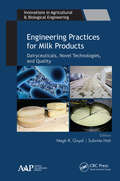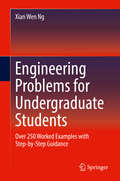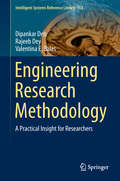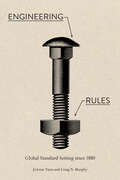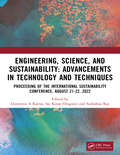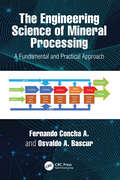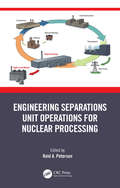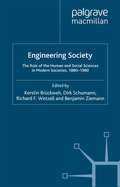- Table View
- List View
Engineering Practices for Management of Soil Salinity: Agricultural, Physiological, and Adaptive Approaches (Innovations in Agricultural & Biological Engineering)
by S. K. Gupta, Megh R. Goyal and Anshuman SinghAbiotic stresses are known to adversely impact agricultural productivity on millions of hectares globally, and it is projected that these problems are likely to increase, primarily due to anthropogenic interventions as well as climatic changes. Understanding abiotic stresses—especially salt stress on soil—calls for an interdisciplinary approach because salt-stressed soils need hydro-technical, chemical, and agronomic interventions as well as an understanding of plant response when exposed to these stresses. This volume explores and conveys the latest information on emerging technologies in the management of abiotic salt stress and their field applications. It brings together experts from various fields (academia, technology, and engineering) to provide the latest information and knowledge on this important challenge.
Engineering Practices for Milk Products: Dairyceuticals, Novel Technologies, and Quality (Innovations in Agricultural & Biological Engineering)
by Megh R. Goyal Subrota HatiWhile also addressing the need for more effective processing technologies for increased safety and quantity, the dairy industry needs to address the growing customer demand for new and innovative dairy foods with enhanced nutritional value. This volume looks at new research, technology, and applications in the engineering of milk products, specifically covering functional bioactivities to add value while increasing the quality and safety of milk and fermented milk products. Chapters in the book look at the functional properties of milk proteins and cheese, functional fermented milk-based beverages, biofunctional yoghurt, antibiotic resistant pathogens, and other probiotics in dairy food products.
Engineering Practices for Milk Products: Dairyceuticals, Novel Technologies, and Quality (Innovations in Agricultural & Biological Engineering)
by Megh R. Goyal Subrota HatiWhile also addressing the need for more effective processing technologies for increased safety and quantity, the dairy industry needs to address the growing customer demand for new and innovative dairy foods with enhanced nutritional value. This volume looks at new research, technology, and applications in the engineering of milk products, specifically covering functional bioactivities to add value while increasing the quality and safety of milk and fermented milk products. Chapters in the book look at the functional properties of milk proteins and cheese, functional fermented milk-based beverages, biofunctional yoghurt, antibiotic resistant pathogens, and other probiotics in dairy food products.
Engineering Principles for Food Process and Product Realization (Food Engineering Series)
by Keshavan NiranjanAs an introductory text book on food engineering principles, this text gives students a firm, quantitative foundation in all aspects of food process and product formulation, packaging, manufacturing processes; engineering aspects of the fate of food in the GI tract; engineering principles of the environmental impact of foods; and principles of process economics and project management. The contents are based on a new definition of Food Engineering which is fit-for-purpose for this day and age:Food Engineering is the work of designing, formulating and manipulating food products which have desired sensory, satiety, health and well-being responses; and developing - across various operational scales - designs for the lowest environmental impact processing, packaging and storage systems capable of realizing the products.Based on this definition, Engineering Principles for Food Process and Product Realization re-defines the core competencies of food engineering, covers the engineering principles needed for food process and product design, and examines the engineering principles relevant to the interactions between food on the one hand, and human health, security and environment on the other – which are the key drivers for the growth of food business. With security, human health and environmental legacy driving business, the engineering paradigm must shift from being farm and preservation focused to becoming consumer focused - which this book aims to achieve. All of these topics are covered at a level that is easy to read and absorb, but with challenging questions and problems which require knowledge integration across topics. This book is uniquely placed to serve as an effective launching pad for undertaking further studies on advanced topics and concepts relating to the design of food processes and products.
Engineering Principles in Biotechnology
by Wei-Shou HuThis book is a short introduction to the engineering principles of harnessing the vast potential of microorganisms, and animal and plant cells in making biochemical products. It was written for scientists who have no background in engineering, and for engineers with minimal background in biology. The overall subject dealt with is process. But the coverage goes beyond the process of biomanufacturing in the bioreactor, and extends to the factory of cell’s biosynthetic machinery. Starting with an overview of biotechnology and organism, engineers are eased into biochemical reactions and life scientists are exposed to the technology of production using cells. Subsequent chapters allow engineers to be acquainted with biochemical pathways, while life scientist learn about stoichiometric and kinetic principles of reactions and cell growth. This leads to the coverage of reactors, oxygen transfer and scale up. Following three chapters on biomanufacturing of current and future importance, i.e. cell culture, stem cells and synthetic biology, the topic switches to product purification, first with a conceptual coverage of operations used in bioseparation, and then a more detailed analysis to provide a conceptual understanding of chromatography, the modern workhorse of bioseparation. Drawing on principles from engineering and life sciences, this book is for practitioners in biotechnology and bioengineering. The author has used the book for a course for advanced students in both engineering and life sciences. To this end, problems are provided at the end of each chapter.
Engineering Principles in Biotechnology
by Wei-Shou HuThis book is a short introduction to the engineering principles of harnessing the vast potential of microorganisms, and animal and plant cells in making biochemical products. It was written for scientists who have no background in engineering, and for engineers with minimal background in biology. The overall subject dealt with is process. But the coverage goes beyond the process of biomanufacturing in the bioreactor, and extends to the factory of cell’s biosynthetic machinery. Starting with an overview of biotechnology and organism, engineers are eased into biochemical reactions and life scientists are exposed to the technology of production using cells. Subsequent chapters allow engineers to be acquainted with biochemical pathways, while life scientist learn about stoichiometric and kinetic principles of reactions and cell growth. This leads to the coverage of reactors, oxygen transfer and scale up. Following three chapters on biomanufacturing of current and future importance, i.e. cell culture, stem cells and synthetic biology, the topic switches to product purification, first with a conceptual coverage of operations used in bioseparation, and then a more detailed analysis to provide a conceptual understanding of chromatography, the modern workhorse of bioseparation. Drawing on principles from engineering and life sciences, this book is for practitioners in biotechnology and bioengineering. The author has used the book for a course for advanced students in both engineering and life sciences. To this end, problems are provided at the end of each chapter.
Engineering Problems for Undergraduate Students: Over 250 Worked Examples with Step-by-Step Guidance
by Xian Wen NgThis textbook supplement deconstructs some of the most commonly-encountered and challenging problems arising within engineering domains such as thermodynamics, separation processes, chemical kinetics, fluid dynamics, and engineering mathematics that are foundational to most engineering programs, as well as many courses in STEM disciplines. The book is organized into a series of 250 problems and worked solutions, with problems written in a format typical of exam questions. The book provides students ample practice in solving problems and sharpening their skill applying abstract theoretical concepts to solving exam problems. The presentation of detailed step-by-step explanations for each problem from start to finish in this book helps students follow the train of thought toward arriving at the final numerical solutions to the problems.Stands as an all-in-one, multidisciplinary, engineering problem-solving resource with comprehensive depth and breadth of coverage;Adopts a highly relevant question and answer pedagogy;Maximizes understanding through clear use of visuals;Emphasizes detailed, step-by-step explanations;Includes supplementary sections of cross-referenced concepts.
Engineering Research Methodology: A Practical Insight For Researchers (Intelligent Systems Reference Library #153)
by Dipankar Deb Rajeeb Dey Valentina E. BalasThe book covers all the important aspects of research methodology, and addresses the specific requirements of engineering students, such as methods and tools, in detail. It also discusses effective research in engineering today, which requires the ability to undertake literature reviews utilizing different online databases, to attribute credit for any prior work mentioned, to respect intellectual property rights while simultaneously maintaining ethics in research, and much more. Further, the book also considers soft skills like research management and planning, dealing with criticism in research and presentation skills, which are all equally important and need to include in research methodology education. Lastly, it provides the technical knowhow needed to file patents in academia, an important area that is often ignored in research methodology books. The book is a particularly valuable resource for PhD students in India and South East Asia, as research methodology is a part of their coursework.
Engineering Risk in Natural Resources Management: With Special References to Hydrosystems Under Changes of Physical or Climatic Environment (NATO Science Series E: #275)
by L. Duckstein E. ParentThe purpose of this paper is to present a methodology for estimating space-time stochastic properties of local climatic factors reflecting global climate change. Specifically, daily precipitation amount and daily mean temperature are considered and illustrated with application to the state of Nebraska, U. S. A. Furthermore, a drought index with and without global climate change is examined. The magnitude and consequences of regional response to anticipated climatic changes are uncertain (Houghton et al. , 1990). Typical questions to be answered are: can time series of hydrological events or 10cal climatic variables such as daily temperature be conditioned in scenarios of future climate change and if so, how can this be utilized ? Can extreme historical drought events be reproduced by a stochastic hydroc1imatological model ? Can such a model be used with General Circu1ation Model (GCM) outputs to evaluate the regional/local effects of climate change scenarios? The approach presented in this paper is an extension of the usual analysis of regional hydrometeorological impacts of climate change: we propose to examine time series of GCM produced daily atmospheric circulation patterns (CP), thought to be relatively accurate GCM output to estimate local climatic factors. The paper is organized as follows. First, daily CPs are classified and analyzed statistically, first for historical and then for GCM produced data. Next, the height of the 500 hPa pressure field is introduced as an additional physically relevant variable influencing local climatic factors within each CP type.
Engineering Risks: Evaluation and Valuation
by Ulrich Hauptmanns Wolfgang WernerEncouragement by colleagues and a considerable increase in the use of prob abilistic analyses since the publication of the German edition in 1987 have motivated this English version. A mere translation was inappropriate because a number of important studies completed in recent years had to be included, among them the assessment of the risks of five nuclear power plants in the United States of America and the German Risk Study, Phase B. The opportunity was taken to elaborate on some concepts which have gained importance of late such as accident management. An update of international safety goals was also made; however, this can only be a momentary view of a field subjected to frequent change. Thanks are due to the Springer-Verlag for the careful editing and production of the book. Kaln, Garching Ulrich Hauptmanns March 1990 Wolfgang Werner Preface to the German Edition With the increasing use of complex technologies there is a growing need to evaluate the associated risks. The methodology of probabilistic safety and risk analysis allows predictive valuation of risks. Nuclear engineering has been in the forefront of the development and application of this method. In the Safety Study on US Power Plants published in 1975 the risk of an entire technology was investigated systematically and quantified for the first time. Meanwhile the methods have continuously been improved and applied to a number of nuclear power stations.
Engineering Rules: Global Standard Setting since 1880 (Hagley Library Studies in Business, Technology, and Politics)
by JoAnne Yates Craig N. MurphyPrivate, voluntary standards shape almost everything we use, from screw threads to shipping containers to e-readers. They have been critical to every major change in the world economy for more than a century, including the rise of global manufacturing and the ubiquity of the Internet. In Engineering Rules, JoAnne Yates and Craig Murphy trace the standard-setting system's evolution through time, revealing a process with an astonishingly pervasive, if rarely noticed, impact on all of our lives. Standard setting was established in the 1880s, when engineers aimed to prove their status as professionals by creating useful standards that would be widely adopted by manufacturers while satisfying corporate customers. Yates and Murphy explain how these engineers' processes provided a timely way to set desirable standards that would have taken much longer to emerge from the market and that governments were rarely willing to set. By the 1920s, the standardizers began to think of themselves as critical to global prosperity and world peace. After World War II, standardizers transcended Cold War divisions to create standards that made the global economy possible. Finally, Yates and Murphy reveal how, since 1990, a new generation of standardizers has focused on supporting the Internet and Web while applying the same standard-setting process to regulate the potential social and environmental harms of the increasingly global economy.Drawing on archival materials from three continents, including newly uncovered documents contributed by key standard setters, interviews, and direct observation of recent Web-related standard setting, Yates and Murphy describe the positive ideals that sparked the standardization movement, the ways its leaders tried to realize those ideals, and the challenges the movement faces today. An in-depth history of the engineers and organizations that developed and operate the vast yet inconspicuous global infrastructure of private, consensus-based standard setting, Engineering Rules is a riveting global history of the people, processes, and organizations that created and maintain this nearly invisible infrastructure of today's economy, which is just as important as the state or the global market.
Engineering Rules: Global Standard Setting since 1880 (Hagley Library Studies in Business, Technology, and Politics)
by JoAnne Yates Craig N. MurphyPrivate, voluntary standards shape almost everything we use, from screw threads to shipping containers to e-readers. They have been critical to every major change in the world economy for more than a century, including the rise of global manufacturing and the ubiquity of the Internet. In Engineering Rules, JoAnne Yates and Craig Murphy trace the standard-setting system's evolution through time, revealing a process with an astonishingly pervasive, if rarely noticed, impact on all of our lives. Standard setting was established in the 1880s, when engineers aimed to prove their status as professionals by creating useful standards that would be widely adopted by manufacturers while satisfying corporate customers. Yates and Murphy explain how these engineers' processes provided a timely way to set desirable standards that would have taken much longer to emerge from the market and that governments were rarely willing to set. By the 1920s, the standardizers began to think of themselves as critical to global prosperity and world peace. After World War II, standardizers transcended Cold War divisions to create standards that made the global economy possible. Finally, Yates and Murphy reveal how, since 1990, a new generation of standardizers has focused on supporting the Internet and Web while applying the same standard-setting process to regulate the potential social and environmental harms of the increasingly global economy.Drawing on archival materials from three continents, including newly uncovered documents contributed by key standard setters, interviews, and direct observation of recent Web-related standard setting, Yates and Murphy describe the positive ideals that sparked the standardization movement, the ways its leaders tried to realize those ideals, and the challenges the movement faces today. An in-depth history of the engineers and organizations that developed and operate the vast yet inconspicuous global infrastructure of private, consensus-based standard setting, Engineering Rules is a riveting global history of the people, processes, and organizations that created and maintain this nearly invisible infrastructure of today's economy, which is just as important as the state or the global market.
Engineering, Science, and Sustainability: Advancements in Technology and Techniques
by Dimitrios A Karras Sai Kiran Oruganti Sudeshna RayISC 2022 is dedicated to the Niti Aayog policies to promote sustainability through exchange of ideas emerging out of the academia. The ISC is an annual conference that is held in virtual mode until COVID restrictions on travel exist. The vision of the conference is to capacitate Academia with the necessary ideas that provide insights of the grassroot level development to various stakeholders of the Niti-Aayog policies. Towards this goal, the conference creates a conjunction of various stakeholders of Niti-Aayog policies that include- academic institutions, government bodies, policy makers and industry. The ISC organizers make concerted efforts to promote academic research that would technological, scientific, management & business practices, and insights into policy merits & disruptions. The framework of exchange of ideas is geared towards adoption of deep technologies, fundamental sciences & engineering, energy research, energy policies, advances in medicine & related case studies. This framework enables the round table discussions between the academia, industry and policy makers through its range of plenary and keynote speakers.
Engineering, Science, and Sustainability: Advancements in Technology and Techniques
ISC 2022 is dedicated to the Niti Aayog policies to promote sustainability through exchange of ideas emerging out of the academia. The ISC is an annual conference that is held in virtual mode until COVID restrictions on travel exist. The vision of the conference is to capacitate Academia with the necessary ideas that provide insights of the grassroot level development to various stakeholders of the Niti-Aayog policies. Towards this goal, the conference creates a conjunction of various stakeholders of Niti-Aayog policies that include- academic institutions, government bodies, policy makers and industry. The ISC organizers make concerted efforts to promote academic research that would technological, scientific, management & business practices, and insights into policy merits & disruptions. The framework of exchange of ideas is geared towards adoption of deep technologies, fundamental sciences & engineering, energy research, energy policies, advances in medicine & related case studies. This framework enables the round table discussions between the academia, industry and policy makers through its range of plenary and keynote speakers.
The Engineering Science of Mineral Processing: A Fundamental and Practical Approach
by Fernando Concha A Osvaldo A. BascurThe Engineering Science of Mineral Processing: A Fundamental and Practical Approach emphasizes the fundamentals of mineral processing to provide readers with a deep understanding of the science and phenomena that occur during the processing of ores. It also offers guidance on contemporary process implementation through practical industry applications. It includes examples of dynamic simulations and practical execution of advanced software to guide operating plans to ensure optimal conditions that predict process constraints. Focuses on the science of mineral processing, including particulate systems, hydrodynamics, and physical chemistry Discusses modeling, rheology, comminution, classification, flotation, and solid-liquid separation Includes practical examples from real-world industrial applications Provides information on dynamic process simulations and the application of digital twins in mineral processing plants to improve management and efficiency Details the future of mineral processing in the digital era. Offering a balance between fundamentals and applications, this book will be of interest to researchers and industry professionals working to optimize mining, mineral and chemical processing plants. It will also be of value to advanced students taking mineral processing and chemical engineering courses.
The Engineering Science of Mineral Processing: A Fundamental and Practical Approach
by Fernando Concha A Osvaldo A. BascurThe Engineering Science of Mineral Processing: A Fundamental and Practical Approach emphasizes the fundamentals of mineral processing to provide readers with a deep understanding of the science and phenomena that occur during the processing of ores. It also offers guidance on contemporary process implementation through practical industry applications. It includes examples of dynamic simulations and practical execution of advanced software to guide operating plans to ensure optimal conditions that predict process constraints. Focuses on the science of mineral processing, including particulate systems, hydrodynamics, and physical chemistry Discusses modeling, rheology, comminution, classification, flotation, and solid-liquid separation Includes practical examples from real-world industrial applications Provides information on dynamic process simulations and the application of digital twins in mineral processing plants to improve management and efficiency Details the future of mineral processing in the digital era. Offering a balance between fundamentals and applications, this book will be of interest to researchers and industry professionals working to optimize mining, mineral and chemical processing plants. It will also be of value to advanced students taking mineral processing and chemical engineering courses.
Engineering Separations Unit Operations for Nuclear Processing
by Reid PetersonEngineering Separations Unit Operations for Nuclear Processing provides insight into the fundamentals of separations in nuclear materials processing not covered in typical texts. This book integrates fuel cycle and waste processing into a single, coherent approach, demonstrating that the principles from one field can and should be applied to the other. It provides historical perspectives on nuclear materials processing, current assessment and challenges, and how past challenges were overcome. It also provides understanding of the engineering principles associated with handling nuclear materials. This book is aimed at researchers, graduate students, and professionals in the fields of chemical engineering, mechanical engineering, nuclear engineering, and materials engineering.
Engineering Society: The Role of the Human and Social Sciences in Modern Societies, 1880-1980
by Kerstin Brückweh Richard F. WetzellExplaining crime by reference to abnormalities of the brain is just one example of how the human and social sciences have influenced the approach to social problems in Western societies since 1880. Focusing on applications such as penal policy, therapy, and marketing, this volume examines how these sciences have become embedded in society.
Engineering Software IV: Proceedings of the 4th International Conference, Kensington Exhibition Centre, London, England, June 1985 (pdf)
by R. A. AdeyEngineering Solid Mechanics: Fundamentals and Applications
by Abdel-Rahman A. Ragab Salah Eldin BayoumiEngineering Solid Mechanics bridges the gap between elementary approaches to strength of materials and more advanced, specialized versions on the subject.The book provides a basic understanding of the fundamentals of elasticity and plasticity, applies these fundamentals to solve analytically a spectrum of engineering problems, and introduces advanced topics of mechanics of materials - including fracture mechanics, creep, superplasticity, fiber reinforced composites, powder compacts, and porous solids.Text includes:stress and strain, equilibrium, and compatibilityelastic stress-strain relationsthe elastic problem and the stress function approach to solving plane elastic problemsapplications of the stress function solution in Cartesian and polar coordinatesProblems of elastic rods, plates, and shells through formulating a strain compatibility function as well as applying energy methodsElastic and elastic-plastic fracture mechanicsPlastic and creep deformationInelastic deformation and its applications This book presents the material in an instructive manner, suitable for individual self-study. It emphasizes analytical treatment of the subject, which is essential for handling modern numerical methods as well as assessing and creating software packages. The authors provide generous explanations, systematic derivations, and detailed discussions, supplemented by a vast variety of problems and solved examples.Primarily written for professionals and students in mechanical engineering, Engineering Solid Mechanics also serves persons in other fields of engineering, such as aerospace, civil, and material engineering.
Engineering Solid Mechanics: Fundamentals and Applications
by Abdel-Rahman A. Ragab Salah Eldin BayoumiEngineering Solid Mechanics bridges the gap between elementary approaches to strength of materials and more advanced, specialized versions on the subject.The book provides a basic understanding of the fundamentals of elasticity and plasticity, applies these fundamentals to solve analytically a spectrum of engineering problems, and introduces advanced topics of mechanics of materials - including fracture mechanics, creep, superplasticity, fiber reinforced composites, powder compacts, and porous solids.Text includes:stress and strain, equilibrium, and compatibilityelastic stress-strain relationsthe elastic problem and the stress function approach to solving plane elastic problemsapplications of the stress function solution in Cartesian and polar coordinatesProblems of elastic rods, plates, and shells through formulating a strain compatibility function as well as applying energy methodsElastic and elastic-plastic fracture mechanicsPlastic and creep deformationInelastic deformation and its applications This book presents the material in an instructive manner, suitable for individual self-study. It emphasizes analytical treatment of the subject, which is essential for handling modern numerical methods as well as assessing and creating software packages. The authors provide generous explanations, systematic derivations, and detailed discussions, supplemented by a vast variety of problems and solved examples.Primarily written for professionals and students in mechanical engineering, Engineering Solid Mechanics also serves persons in other fields of engineering, such as aerospace, civil, and material engineering.
Engineering Solutions for Sustainability: Materials and Resources II (The Minerals, Metals & Materials Series)
With impending and burgeoning societal issues affecting both developed and emerging nations, the global engineering community has a responsibility and an opportunity to truly make a difference and contribute. The papers in this collection address what materials and resources are integral to meeting basic societal sustainability needs in critical areas of energy, transportation, housing, and recycling. Contributions focus on the engineering answers for cost-effective, sustainable pathways; the strategies for effective use of engineering solutions; and the role of the global engineering community. Authors share perspectives on the major engineering challenges that face our world today; identify, discuss, and prioritize engineering solution needs; and establish how these fit into developing global-demand pressures for materials and human resources.
Engineering Solutions Toward Sustainable Development: Proceedings of 1st International Conference on Engineering Solutions Toward Sustainable Development (Earth and Environmental Sciences Library)
by Abdelazim M. Negm Rawya Y. Rizk Rehab F. Abdel-Kader Asmaa AhmedThis book constitutes the referred proceeding of the 1st International Conference on Engineering Solutions Toward Sustainable development (ESSD2023), organized by the Faculty of Engineering, Port Said University and held in Port Said, Egypt, during May 2-3, 2023. The book is devoted to fulfill the need for sustainable development that has never been more urgent. It shows the crucial role of engineering to play in this transition from consumption culture to responsible culture. This book explores the relationship between engineering and sustainability, highlighting the vital role that engineering plays in achieving sustainable development. The book provides a comprehensive guide for engineers, researchers, and experts from different disciplines that are interested in sustainable development. From renewable energy sources to green infrastructure, the book delves into the latest technological advancements providing insights and practical strategies for designing and implementing sustainable solutions. With practical examples and case studies, readers will gain a deep understanding of how engineering principles and practices can be harnessed to develop sustainable solutions that balance economic, social, and environmental needs and to mitigate the negative impacts of human activity on our planet. The books is very useful for graduate students, researchers, policy planners, decision makers and stakeholders in the field of renewable energy, clean water development, climate actions, smart cities and communities and green infrastructures.
Engineering Standards for Forensic Application
by Robert N. Anderson Richard W. MclayEngineering Standards for Forensic Application presents the technologies and law precedents for the application of engineering standards to forensic opinions, discussing Fundamentals, Disciplines, Engineering Standards, The Basics and the Future of Forensics. The book explores the engineering standard and how it is used by experts to give opinions that are introduced into evidence, and how they are assumed to be the best evidence known on the topic at hand. Final sections include coverage of NFL Brain Injuries and the Flint Water Crisis. Examples of the use of engineering standards are shown and discussed throughout the work. Addresses a wide variety of forensic engineering areas, including relevant lawProvides a new approach of study that includes the work of both engineers and litigatorsContains contributions from over 40 experts, offering the reader examples of general forensic methods that are based on reliable engineering practice
Engineering Statics
by M. Rashad Islam M. Abdullah Al Faruque Bahar Zoghi Sylvester A. KalevelaEngineering Statics presents the cutting-edge topics in engineering statics, focusing on practical applications knowledge, with numerous real-world examples, practice problems, and case studies throughout. It covers theory concisely and uses plain language and coverage that can be completed in a one-semester course. It also covers the related concepts required to take the Fundamentals of Engineering (FE) exam. Features: Written in plain language, with numerous realistic step-by-step examples. Covers topics required to understand and prepare for the Fundamentals of Engineering (FE) exam. Includes practical case studies, concise theory and numerous solved practice problems. Engineering Statics is suitable for undergraduate students in civil and mechanical engineering courses, as well as those in Engineering Technology and Applied courses. This book includes material suitable for first and second-year undergraduate courses, as well as more senior students. The authors believe that this text will be very helpful for students to succeed in their degree programs and professional careers.

